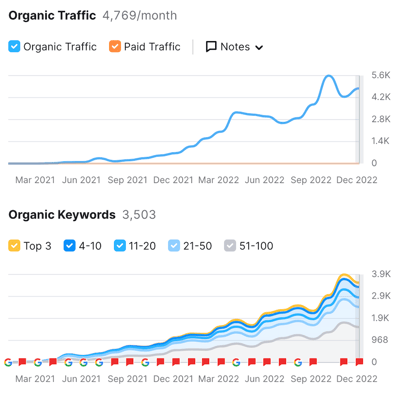Tl;dr - The difference between content that drives revenue vs. not is simply rigor in the process. Evergreen content connects with buyers by speaking to their priorities (often well beyond yours) in an engaging way. A proper plan will help you consistently produce content that attracts cumulatively larger audiences, establishes your brand as authoritative, helps your sales team with business development, and over time creates attributable revenue.
What is Evergreen Content for Manufacturing Marketing?
An evergreen content definition is simple. It is online material that is perennially pertinent and relevant to your target audience. It must be, first, significantly helpful and insightful for your target buyer personas; and, second, well-optimized for search engines and the questions your potential prospects ask.
Evergreen content will consistently deliver significant numbers of new visitors to your site, will engage them when they arrive, and should help generate leads. Time on page and new visitor entries via that page (important SEO KPIs) will be high, and the content will continue to perform month after month and year after year.
 Consistent evergreen content fuels a gradual, cumulative and sustainable growth in search traffic, inbound leads, and business opportunities at all stages of your buying funnel, and helps build authority and trust in buyers who come to recognize your brand as an industry leader. The best content provides readers with notable "ah ha" moments and gives them tools and insights to improve their job performance and outcomes.
Consistent evergreen content fuels a gradual, cumulative and sustainable growth in search traffic, inbound leads, and business opportunities at all stages of your buying funnel, and helps build authority and trust in buyers who come to recognize your brand as an industry leader. The best content provides readers with notable "ah ha" moments and gives them tools and insights to improve their job performance and outcomes.
Why is Evergreen Content Important for Industrial Manufacturers?
 Many industrial manufacturers find content creation to be the biggest challenge of inbound content marketing. Manufacturing marketing budgets are smaller for industrial companies than for the software companies that innovated the inbound marketing methodology. Staff is focused on engineering, production, operations, and sales - not digital marketing strategy, and not copywriting and editing.
Many industrial manufacturers find content creation to be the biggest challenge of inbound content marketing. Manufacturing marketing budgets are smaller for industrial companies than for the software companies that innovated the inbound marketing methodology. Staff is focused on engineering, production, operations, and sales - not digital marketing strategy, and not copywriting and editing.
So when they do create content, it needs to carry more weight. If your company blogs five times a week, and you have an off day or two, you can succeed with strong results with the rest. But if you only blog once a week, only drop a press release (inherently NOT evergreen content, but it can be creatively optimized for ongoing results) every two months, and only publish a new offer with landing page every quarter, then each piece has to perform well over the long term reaching and engaging potential customers.
The detail-oriented target buyers of many industrial companies include engineers, production and maintenance experts who value meaty, insightful, actionable content and disdain fluff. Evergreen content often speaks to this need by focusing on topics and questions that consistently vex their complex operations. Across the target market, significant percentages of professionals are ALWAYS searching for answers to these challenges.
It's a perfect opportunity for manufacturers - to answer the questions that your prospects always ask and which will impact their business. They find you (including many you'd never know of otherwise), associate you with expertise and value, and often introduce themselves for you to gradually build trusting and impactful relationships that yield results when it's time for them to buy.
Examples of Evergreen Content for Manufacturing Companies
 Let's look at examples of what is and what is not evergreen content.
Let's look at examples of what is and what is not evergreen content.
Topics of passing interest are NOT. For instance, a blog article about how an imminent tax change will impact decisions around buying capital machinery. That doesn't mean it's not important content or that you shouldn't write about it. It might well merit a webinar discussion which could be announced with a press release and recapped in a blog article. And it should be mentioned in a periodic email update to your list. But three years from now, nobody will be searching for it.
Similar examples include your introduction of a product update (remember evergreen content is about them, not you!), attending a trade show, hiring a sales rep, or receiving a new patent. All are appropriate content topics, but not the subjects for evergreen content.
Trends may be evergreen. Examples from the food industry that many of my clients target for their machinery could include changing buyer tastes (sustainable packaging, store perimeter fresh vs. store interior processed food), alternative proteins, the FSMA (FDA's Food Modernization Safety Act), and retail trends like Wal-Mart's "Shelf Ready" initiative.
Some of these are slow-moving and will be topics of interest for some years, but they're changing, and your content will have to keep up. One advantage of these topics is that it often helps you to reach buying team members that you might not normally engage. Often marketing, food science and food safety, merchandising, and finance people will be involved early in observing trends. Creating those relationships via relevant content will deepen your connections with prospect companies and lead to warm introductions to your primary target buyers. You can often influence that project specs well in advance.
Consistent operational challenges are effective evergreen topics. Improving OEE, minimizing process loss, increasing production speed, increasing MBTF, simplifying ongoing operator training, and addressing the ubiquitous Achilles Heel of your function are all appropriate topics.
All of these can be addressed in videos, webinars (which can be recorded and made available on-demand as evergreen), downloadable guides, articles, checklists, case studies, and more.
An important caveat...they must matter to the buyer. For instance, many manufacturers talk about their service/support and machine durability. Buyers generally don't care. Further, leading with your "solution" loses the audience. You must lead with and focus on the challenge they have, solutions they might have tried, implications to their operation, and provide actionable brand-agnostic recommendations. A small mention of your proprietary solution at the end, with an opportunity to learn more, is ideal.
How Do You Create Evergreen Content for Industrial Manufacturers?
As companies move past the first question, "What does evergreen mean in marketing?" they have to effectively transition to executing as part of their industrial inbound content marketing effort.
There are three keys to creating evergreen content as part of your manufacturing marketing program.
- buyer research
- SEO research
- conversational, no BS, authoritative content
Evergreen Content is Built on Deep Buyer and SEO Research
 If we go back to the evergreen content definition, we know that for content to endure and drive traffic and leads for years, it must resonate deeply with your target audience. Further, it must achieve and maintain superb search ranking and CTR (click-through rate.)
If we go back to the evergreen content definition, we know that for content to endure and drive traffic and leads for years, it must resonate deeply with your target audience. Further, it must achieve and maintain superb search ranking and CTR (click-through rate.)
These don't happen accidentally.
Most companies speak about their products. Many do so explicitly. Others a bit more obliquely by yammering on about the category without actually focusing on their brand and model names. But with few exceptions, that's not what your buyers spend their time thinking about.
In capital equipment sales, you probably sell machines with 7-15 year functional lifespans. If the typical sell cycle is 6 months, that means that they're focused on the product for an average of 6 months/144 (12 years) = 4% of the time.
The other 96% of the time, they're thinking about completely unrelated topics (reducing cooling and heating energy consumption, retaining 3rd shift employees, cycle counting inventory, 401K program regulatory compliance, etc., etc., etc.)
They also spend time thinking about how to incrementally increase production, reduce waste, reduce downtime, adapt to new market trends with agility, etc.
You need to understand the issues they're focused on. That only comes with ongoing, nuanced, quantitative and qualitative buyer research. This includes extensive monitoring and consumption of business and industry news, and regular interviews with stakeholders in the industry - particularly each of the roles on buying teams in your typical prospect company.
Now, many will say "Our business is machines that do ABC. We don't know anything about 401K programs." I understand. Calm down.
You do know that the biggest problems facing manufacturing companies for the last several years have been talent and supply chain. And we know that energy costs are rising - so quickly that in some markets, certain types of factories are being mothballed.
So with only modest effort you can build an editorial calendar that's designed to speak to your buyers (not make your myopically focused COO and VP of engineering comfortable) as follows:
- Constantly update a contemporaneous list of key issues facing each buying role. Some of these will be perennial (reducing waste in your process), and others will be medium to long-term (tips on retaining food industry workers, raw material sourcing trends, reducing energy consumption of ABC function). Even go so far as to ask people, "How would you ask Google that question?"
- Continuously track SEO key term trends with competitors, trade groups, and regulatory agencies to identify high-opportunity key terms (volume vs. difficulty) to target
- Identify legitimate experts in your space that have insights into these. For some, your engineering and field maintenance team will be perfect. But you can also turn to your trade association employees and research, educational extension programs, other companies that sell other solutions to the same customers as you, consultants in various disciplines, your vendors, and regulatory agency folks
- Build an editorial calendar at least a quarter out that includes all of your content and channels and determines all aspects of primary and related key term optimization, including topic pillars and internal linking
- Identify other content outlets (podcasts, industry trade journals, etc.) where your internal SMEs (subject matter experts) might offer valuable contributions as guests/contributors
- Create some email templates and telephone talk tracks for appropriate outreach to external contributors - including the value to them of participating
- Your content team, with some quick research, will identify appropriate contributors for each piece and reach out directly or through intermediate connections that can be quickly identified on LinkedIn
- Get their agreement to be interviewed, cited, join a webinar, contribute to a guide, etc.
- Do the heavy lifting of creating the content - according to your schedule. Rigorously optimize according to the SEO research that cascaded from your buyer research
- Tag your collaborators and contributors, and their companies when appropriate, to aid in your content distribution
- Promote the content. Content distribution and promotion will help with inbound links, which will support your efforts
- Track performance, periodically republish aging content, and optimize for conversions on high-performing content
This method (Manufacturing Journalism™) will ensure you speak to real buyer concerns (not the filtered self-serving list your internal folks normally provide) in a technically optimized way to ensure your target buyers are likely to engage with it. It will let you publish authoritatively on a variety of topics that are important to your buyers; both directly related to your functions (often your own internal experts) and tangential (outside contributors.)
But that's not quite enough.
Tone & Style
Academic papers and dry professorial explanations aren't going to work. Your content must be accessible and conversational. Your style guide (you have one, right?) should ensure consistent content built on best practices for headlines, lists, paragraph length, article length, scannability, etc.
This will be uncomfortable for many industrial companies who tend to think of user manual technical writing as the appropriate method. Want to use that in your knowledge base? Fine. But not in your content.
Creating evergreen content doesn't happen accidentally. You must understand who you're speaking to, what they're worried about, how they'll find your answers - and then you must deliver those answers in compelling, digestible forms.
How Can You Fully Use Evergreen Content for Manufacturing Revenue Growth?
It's not enough to drive great SEO and traffic results. Traffic has to be turned into leads, leads to meetings, meetings to projects, and projects to closed/won revenue.
Evergreen content plays a role in each phase, and effective marketing teams rely on metrics and A/B testing to improve their results.
Let's look at a few key steps in turning evergreen content into revenue.
- Don't stop - some content will work well. Some won't. Each piece will be a struggle to complete as the SMEs in your firm will be generally skeptical. The chart above shows that even starting from zero, consistent, deliberate work will drive significant results within your forecast and projection window.
- Consistently improve each step - monitor your top-performing content (time on page and new entries.) Try to discern what insights you can use to improve new content. Focus on boosting the visitor/lead conversion rate on that content with CTAs, chatbots, landing page testing, form improvement, etc. Use progressive evergreen content to gradually deepen engagement. Use first-party intent signals from evergreen content engagement to improve lead scoring and drive effectively to meetings. Create evergreen content for each buying team role and stage in the buying journey. Publish it to capture leads, but train your sales team on how to deploy it for sales enablement in their active projects.
- Score leads effectively - many inbound leads that result from evergreen content will be very early stage and not sales leads in any practical sense. A 3rd shift maintenance manager who downloads your guide to improving the OEE of equipment like yours is evidencing some production problems but is unlikely to turn that frustration into a project. So lead scoring needs to help manage the marketing and inbound sales movement to turn the intent insight into engagement. That, in turn, takes enablement content, sales coaching, and management patience with account development vs. an exclusive focus on pipeline creation.
Turns out that marketing and sales are deeply intertwined. That's the premise of Overall Revenue Effectiveness™!
Evergreen Content is a Corporate Asset
Creating a body of effective evergreen content will take some time, consistent effort, and strong management support.
The payoff can be significant. You'll create more leads, and uncover new contacts and companies with whom you should engage, establish industry authority, build trust, and win more deals.
However, rigor and precision in execution will make the difference between success and failure. Companies with good intentions but undisciplined execution may invest significant time and generate limited results. Don't fall into that trap.
Using Evergreen Content To Support the Business Development Process
Evergreen content is a great example of a tactic that sits at the intersection of marketing strategies and sales efforts. Business development strategies should seek to attract potential customers, engage them with content and marketing automation, and help sales reps to connect with them in a meaningful way. This should help to shorten sales cycles and boost sales efforts.
Growth strategies should consider the full lifecycle from creating qualified leads through engaging with decision makers, and measure new business growth and ideal customer penetration.


